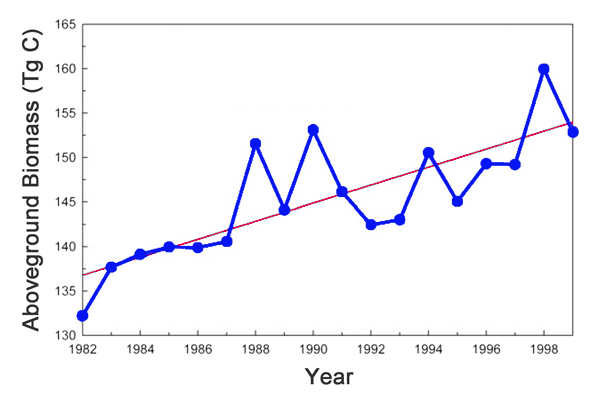The State of Earth's Terrestrial Biosphere:
How is it Responding to Rising Atmospheric CO2 and Warmer Temperatures?
Continental-Scale Analyses of Terrestrial Productivity: Asia (China - Grasslands)
Noting that the climate of China's temperate grasslands "experienced dramatic change in the past several decades," Piao et al. (2006) thought it important to investigate the impact of that climate change on the productivity of the country's grasslands. This they did by analyzing Normalized Difference Vegetation Index (NDVI) data obtained from the U.S. National Oceanic and Atmospheric Administration's very high resolution radiometer at a spatial resolution of 8 x 8 km and at 15-day intervals from January 1982 to December 1999, comparing those results with temperature, precipitation and Thornthwaite (1948) moisture index data generated from 680 well-distributed climate stations across China.
Piao et al.'s results indicated little to no increase in precipitation and moisture index, respectively, over the period of their study. In the case of temperature, however, there was a least-squares linear warming of 0.89°C between 1982 and 1999 with R = 0.59 and P = 0.009, which they described as "dramatic." Even more dramatic, however, was their finding that "mean growing season NDVI increased significantly (R = 0.73, P = 0.001) from 0.25 in 1982 to 0.28 in 1999," or by approximately 12%.
At first glance it would appear that the dramatic increase in temperature is what drove the dramatic increase in grassland productivity. However, more detailed analyses revealed, in the researchers' words, that "the positive effect of temperature on the growth of grassland decreased [italics added] as temperature rose [italics added]."
So what might have compensated for the temporally-decreasing strength of the growth enhancement provided by the warming of the region? As possible contenders, Piao et al. mention the "atmospheric CO2 fertilization effect, increased nutrient deposition, and human activity such as grazing management [and] land abandonment due to migration into urban areas."
One year later, using national grassland resource inventory data, a normalized difference vegetation index (NDVI) time series data set, and a satellite-based statistical model, Piao et al. (2007) identified changes in the size and distribution of the aboveground biomass carbon (C) stocks of China's grasslands between 1982 and 1999. Specifically, the authors found that over the 18-year period of their study, "aboveground biomass C stocks ... significantly increased from 136.3 Tg C in the early 1980s to 154.0 Tg C in the late 1990s," for a total increase of 13% (Figure 10). As for what factors might have been responsible for the C-stock increase, they note that "growing season average temperature for the study area increased by 0.052°C per year and growing season precipitation also tended to increase," which led them to conclude that "increased temperature may be associated with increasing C stocks and interannual changes in precipitation may be a factor in the fluctuations of C stocks." In addition, they suggest the "atmospheric CO2 fertilization effect and human activity such as land management may also partly account for the observed increase in biomass C stocks of China's grassland."

Figure 10. Interannual variations in aboveground biomass for China's grassland over the period of 1982-1999. Adapted from Piao et al. (2007).
Lastly, in a somewhat different study, Peng et al. (2010) used snow-depth measurements collected at 279 meteorological stations scattered across China, plus collocated satellite-derived Normalized Difference Vegetation Index (NDVI) data, to investigate spatio-temporal changes in snow depth over the period 1980-2006 and the effects of those changes on vegetative growth the following spring and summer. In doing so, the five researchers learned that "over the past three decades, winter snow depth overall increased in northern China, particularly in the most arid and semiarid regions of western China where desert and grassland are mainly distributed," and they say that in those specific areas there were positive correlations between mean winter snow depth and spring NDVI data. More germane to this review, however, they note that Piao et al. (2005) determined that the net primary productivity of the same desert and grasslands during 1982-1999 "increased by 1.6% per year and 1.1% per year, respectively," and that "desertification has been reversed in some areas of western China since the 1980s," citing the work of Runnstrom (2000), Wu (2001), Zhang et al. (2003) and Piao et al. (2005a).
In discussing the implications of their findings, Peng et al. write that the "increase in vegetation coverage in arid and semiarid regions of China, possibly driven by winter snow, will likely restore soil and enhance its antiwind-erosion ability, reducing the possibility of released dust and mitigating sand-dust storms," while noting that the frequency of sand-dust storms has indeed "declined in China since the early 1980s (Qian et al., 2002; Zhao et al., 2004)." Thus, as the world has warmed over the past three decades, there has been another concomitant climatic change across China above 40°N latitude (an increase in winter snow depth) that has prompted a biological change (increased vegetative growth in desert areas and grasslands) that has prompted yet another climatic change (a reduction in sand-dust storms), all of which changes amount to positive developments.




